Abstract
Context:
The interest and popularity of Pilates is increasing worldwide. In addition to being used in fitness programs, it is being used in some rehabilitation programs.
Evidence Acquisition:
This review summarizes level III evidence from 1995 to 2009 obtained from PubMed (MEDLINE), CINAHL, and the Internet. Meta-analyses, systematic reviews, randomized controlled trials, and controlled trials published in peer-reviewed journals were retrieved for appraisal. The keywords searched were Pilates and core stabilization.
Results:
Ninety articles were identified in MEDLINE and CINAHL; 9 articles satisfied the inclusion criteria for level III evidence.
Conclusion:
There is a scientific basis for the effectiveness of Pilates exercise, with limited evidence to support it as a rehabilitative intervention.
Keywords: Pilates, rehabilitation, core strengthening
Joseph Pilates was self-educated in anatomy, bodybuilding, boxing, wrestling, yoga, gymnastics, and martial arts. At the outbreak of World War I, he was interned as an enemy alien in England and became a nurse-physiotherapist to his fellow internees who were sick or injured. He took bedsprings and rigged them to posts, headboards, and footboards of the bed frames, transforming them into resistance-type equipment for disabled patients. These designs were the early models of his universal reformer (Figure 1) and trapeze table (the “Cadillac”; Figure 2) and are the benchmark apparatuses in every Pilates studio today.
Figure 1.
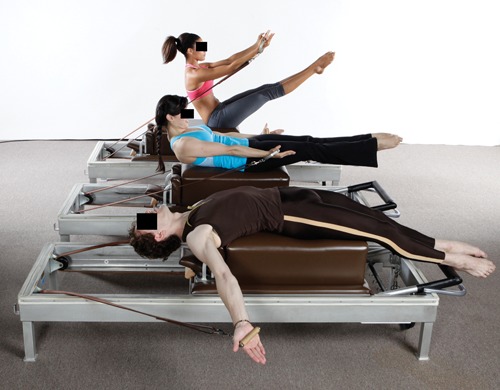
The reformer (image courtesy of True Pilates, New York, New York).
Figure 2.
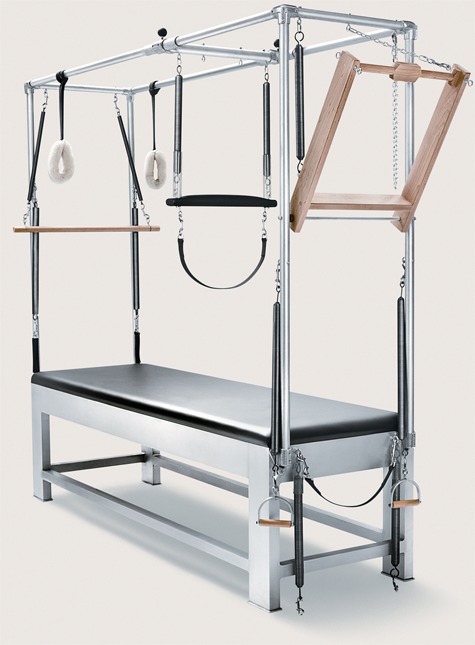
The trapeze table, or Cadillac (image courtesy of Gratz Industries, Long Island City, New York).
Joseph Pilates published 2 books,59,60 the first in 1934 and the second in 1945, in which he passionately described his overall philosophy on holistic health and balanced well-being but not his method of exercise. Pilates believed that his method, called contrology, would activate brain cells to stimulate the mind and affect the body.60 Recently, science has substantiated that exercise improves cognition—specifically, executive function.11,16,70,71
Fad or trend?
In Google, there are 16 400 000 entries for Pilates. Entering the term Pilates exercise reduces that to 11 700 000. There are also 330 000 citations for the benefits of Pilates. In 2000, Yahlin Chang reported in Newsweek that 10 years ago, 5000 people did Pilates exercise; today, the number is 5 million in America alone.14 According to a 2005 Sporting Goods Manufacturers Association Topline Report,50 the growth of Pilates skyrocketed from 1.7 million in 2000 to 10.5 million in 2004; 67% of Pilates participants took up the activity in 2002. The growth rate from 2000 to 2006 was 613.3%.38 The American College of Sports Medicine’s survey of fitness trends worldwide shows Pilates emerging as its own category, ranking seventh in 2008 and 2009.69 Despite its global popularity over the last decade, research on the efficacy of Pilates work has been scant, riddled with limitations and flaws in design.
Joseph Pilates’s work has been passed down in an almost folklore fashion: upheld and preserved by very few. Essentially, classical Pilates has not changed since its inception. There has not been an accreditation or even documentation of the original Pilates principles, methods, techniques, logic, or reasoning.25-27,59,60,74 This lack of standardization has resulted in the term Pilates being applied to the wide variation of exercises and techniques now in practice.
Pilates’s method centered on each individual’s needs “at that time.” Pilates believed that mastering exercises using the least and, ultimately, no resistance or assistance was the pinnacle of performance. He invented his apparatus as an aid to learning movement patterns; mastering the mat program was the method’s goal, with the final outcome being transference to more functional and integrative movement. Individualized instruction can be costly and time-consuming but, when provided by an instructor with proper training, safe and beneficial.10,17,18,20,23,25,62
Pilates is not yoga or dance, and most important, Pilates is not physical therapy.25 The rehabilitation stage, patient limitations, and qualifications of instructors are all essential factors for the medical provider considering a Pilates prescription.
The Principles Of Pilates
The “mind over matter” concept is the central element of the Pilates method. The goal is to fuse the mind and body so that without thinking, the body uses the greatest mechanical advantage to achieve optimal balance, strength, and health (Table 1).
Table 1.
| Centering | Refers to the core of the body, or the “powerhouse,” and is where all energy begins and then radiates outward to the extremities. |
| Concentration | It is the mind that guides the body; hence, focused concentration on one’s entire body with every exercise is necessary when executing Pilates’s exercises. |
| Control | When the work of the exercise is done from the center with concentration, then one will be in control of the movements preformed. |
| Breath | Pilates believed that proper breathing was the most important aspect to his method: “Even if you follow no other instructions, learn to breathe correctly.”59 Exhalation is stressed using the visualization of “wringing out the lungs.” Pilates saw forced exhalation as the key to full inhalation. All exercises are done with full and rhythmic breathing, inhaling on the point of effort to oxygenate all tissues of the body and exhaling to the purge all cellular waste. |
| Precision | The focus is on doing one precise and perfect movement rather than many half-hearted ones. A common adage spoken by instructors to reflect this is “It is not how many but how.” |
| Fluidity | There are no static, isolated movements because our bodies do not naturally function that way. Each exercise flows with graceful succession and a “minimum of motion” into the next to achieve purposeful and economic movement, which then carries over into everyday life. |
The “Core”
Joseph Pilates is credited for labeling the core, or center, “the powerhouse.”74 The general consensus regarding the anatomical boundaries of the “core” are from the pelvic floor inferiorly to the ribcage superiorly and is consistent with most of the current operative definitions.2,24,43,47,54,62,77 Centering is the focal point of the Pilates method.
However, Pilates differed in his description of “centering,” representing it as a “box” delineated by 2 horizontal lines: 1 line running from shoulder to shoulder and the second line running from hip joint to hip joint.13,27,47Center, core, and powerhouse are conventional terms used interchangeably, not only in Pilates’s parlance, but in the medical and fitness communities as well.2,54,55 However, when defining the core by the limits of the box,13,48,54,55 Pilates included the shoulder and hip girdles in total core strengthening. (Figure 3) He then took exercise a step further by enlisting the simultaneous participation of the extremities—total arm strengthening and total leg strengthening—all with control and precision. In other words, Pilates = total core strengthening (TCS) + total arm strengthening (TAS)19,63 + total leg strengthening (TLS).29,56
Figure 3.
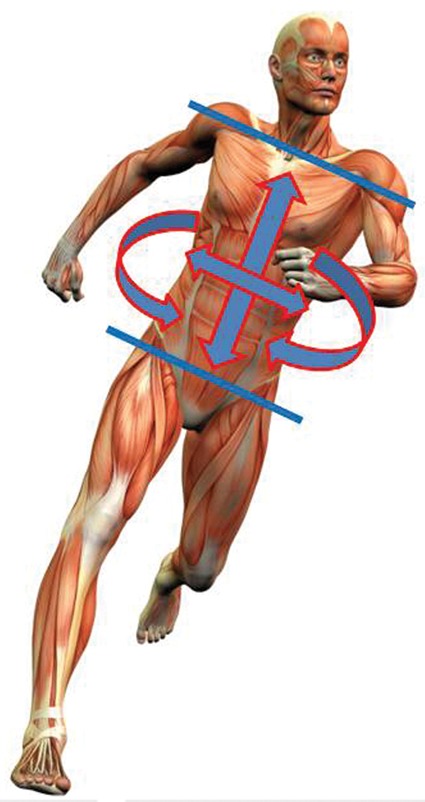
Pilates and total core strengthening. Image courtesy of Peter Galbraith www.dreamstime.com.
Core stabilization has become a staple in most rehabilitation, fitness, and performance enhancement programs. Kibler stated that there is no single universally accepted definition of core stability.43 Several studies suggest that the transversus abdominis (TrA) and multifidi are the key muscles to stabilize the (lumbar) spine.* However, other studies challenge the importance of these muscles as major spinal stabilizers (Figure 4).1,15,52,53,77
Figure 4.
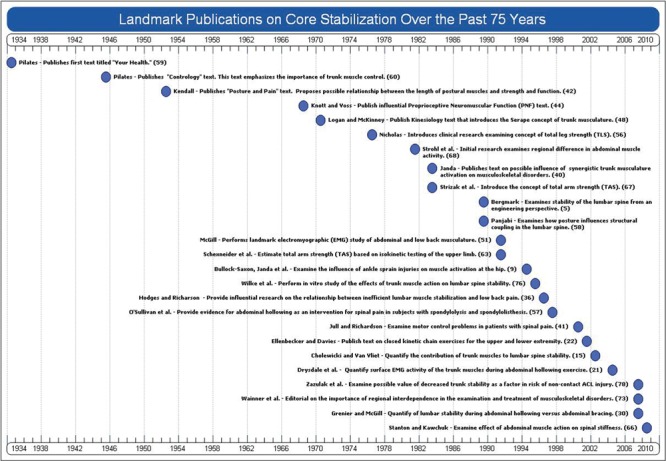
Timeline of key publications for core strengthening.
Research indicates that there is no single element of the core that is inherently more important than another.15,77,78 When evaluating the Pilates method and analyzing its effectiveness, the emphasis on rhythmic breathing, mental focus, motor learning, individualized practice, and total core control cannot be parceled out. An exercise must be executed correctly to master the precision and flow and, ultimately, the transference to functional activities.
Investigating the relative contribution of core muscles to lumbar spine stability, Cholewicki and Van Vliet reported that no single core muscle can be identified as most important for lumbar spine stability and that stabilization exercises may be most effective when they enlist the entire spinal musculature under various loading conditions.15
One of the key Pilates techniques to align, lengthen, and protect the spine is to draw the navel to the spine. Abdominal hollowing, or the abdominal drawing-in maneuver,23 preferentially recruits TrA, internal obliques, and multifidi.4,33,61 One of the proposed benefits of hollowing is to decrease the laxity of the sacroiliac joint more than abdominal bracing.61 Using real-time ultrasound, Endelman23 demonstrated that the Pilates technique of abdominal hollowing is effective in recruiting the TrA and the internal obliques.
Motor Learning
Many sport-specific training techniques have been based on the part-task training concept as an effective way to retrain some tasks.64,75 However, this is true only if the task itself can be divided into units that reflect the inherent goals of the task.64,75 Movement in one area affects the relationship of the other body parts.13 Motor learning focuses on the acquisition or modification of movement and posture.65 In 1945, Pilates’s contrology was defined as developing the body uniformly and correcting postures.60
Pilates emphasized posture as an integrated whole-body activity. Muscles not primary to the movement pattern remain actively engaged and in alignment with each exercise. This concept exemplifies muscle integration in lieu of isolation and illustrates an application of the regional interdependency approach. Total leg strengthening,29,56 total arm strengthening,19,63 and total core strengthening capitalize on the radiation concept,44 whereby weaker muscles are facilitated by the stronger ones in the movement pattern.
Alignment
Pilates exercises emphasize neutral alignment of the pelvis, scapulae, and spine. The joints are always stacked: shoulders over hips, hips over knees, and knees over ankles. The pelvis is leveled, and the lumbar and thoracic curves are neutralized. Many of the Pilates exercises are nearly impossible to perform without this alignment.
In the Pilates stance, body weight is maintained slightly forward on the balls of the feet. With the core already engaged and with alignment optimal, the spine is prepared and protected for performing more skilled tasks. To stabilize the spine for a movement pattern, the TrA and multifidi activate up to 100 milliseconds prior to limb movement,24,31,36,64 regardless of limb direction.36 Increased core muscle activity is needed on unstable surfaces or with a single-limb stance.6,72 However, a recent study has challenged the bilateral symmetry of TrA feed-forward activity.1
Optimal Muscular Development
Progressions of Pilates exercises are achieved by manipulating the effects of gravity, base of support, length of levers, and center of gravity. Spring tension exercises muscles dynamically in a concentric and eccentric mode. Isometrics are also a part of every exercise pattern (Figure 5).
Figure 5.
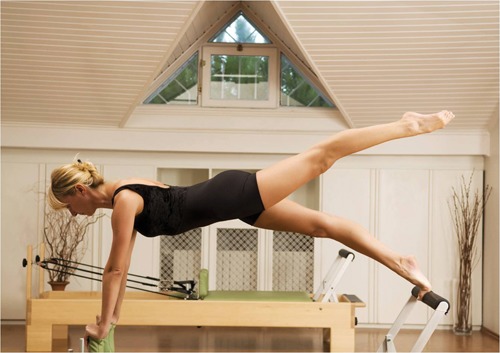
The participant is in the starting position of the push-up front, an advanced Pilates exercise for balance control and strengthening of the upper body, while challenging the total core for stabilization. She will engage her shoulder flexors concentrically along with the synergistic eccentric action of the shoulder extensors to push the spring-loaded carriage forward. When the carriage is returned to the starting position, the shoulder flexors eccentrically act in tandem with the synergistic concentric muscle contractions of the shoulder extensors to control the spring recoil of the carriage return. From the initiation of the exercise to its completion, the trunk, pelvis, hips, and shoulder girdles (total core strengthening) and limb musculature isometrically contract to stabilize her body in this plank pose. Three to 5 repetitions are preformed with 1 leg elevated. This is then repeated with the contralateral leg.
To optimally train the core, McGill recommended the development of muscular endurance over core muscular strength for preventing and rehabilitating low back injuries.52 The lumbar-stabilizing multifidi are mainly composed of type I fibers requiring only low loads to improve performance.3 These muscle activation levels (ie, less than 50% of maximal voluntary contraction), when combined with longer tension times and low movement velocities, represent an ideal stimulus for development of core muscular endurance.12 This research provides the scientific basis to substantiate the Pilates approach to core training.
Apparatuses
There are 12 original pieces of Pilates equipment: the reformer (Figure 1), Cadillac (Figure 2), pedi-pull (Figure 6), wunda chair (Figure 7), electric or high chair (Figure 8), magic circle (Figure 9), ladder barrel (Figure 10), small barrel (Figure 11), baby chair (Figure 12), mat (Figure 13), spine corrector (Figure 14), toe corrector (Figure 15), and breath-a-cizer (Figure 16).
Figure 6.
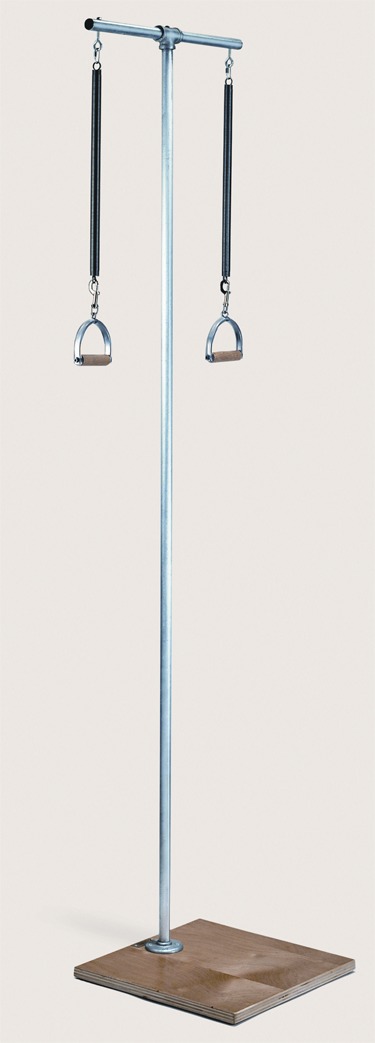
The pedi-pull (image courtesy of Gratz Industries, Long Island City, New York).
Figure 7.
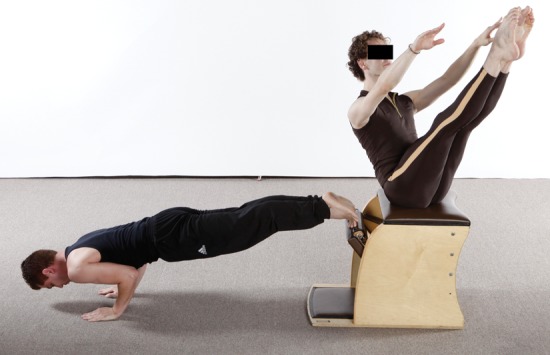
The wunda chair (image courtesy of True Pilates, New York, New York).
Figure 8.
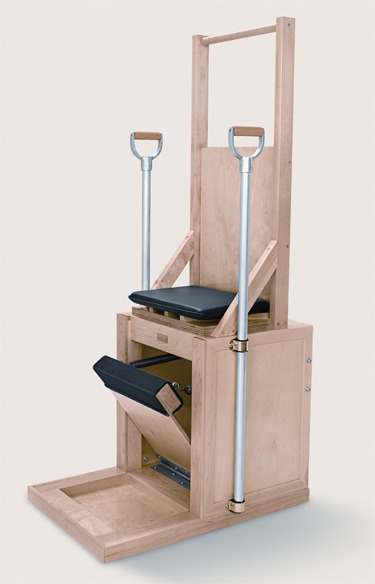
The electric or high chair (image courtesy of Gratz Industries, Long Island City, New York).
Figure 9.
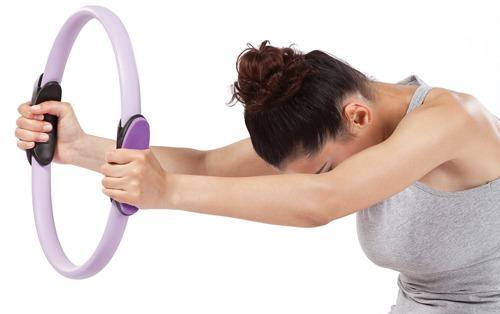
The magic circle (from iStockphoto).
Figure 10.
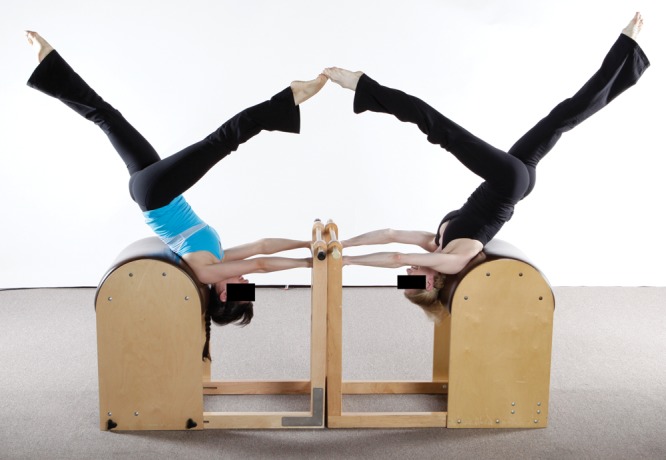
The ladder barrel (image courtesy of True Pilates, New York, New York).
Figure 11.
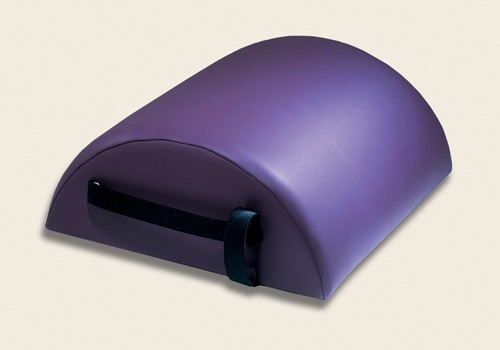
The small barrel (image courtesy of Gratz Industries, Long Island City, New York).
Figure 12.
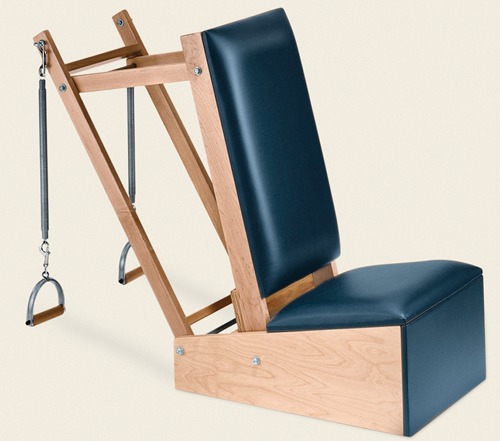
The baby chair (image courtesy of Gratz Industries, Long Island City, New York).
Figure 13.
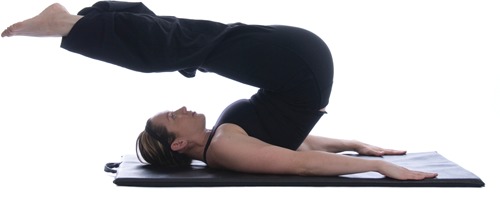
The mat (from iStockphoto).
Figure 14.
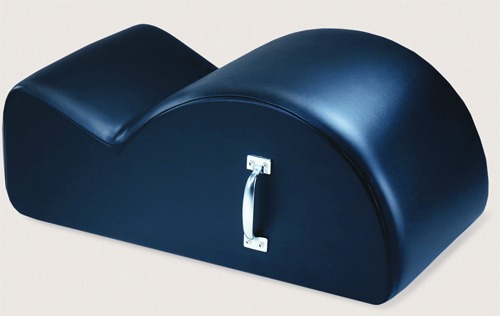
The spine corrector (image courtesy of Gratz Industries, Long Island City, New York).
Figure 15.
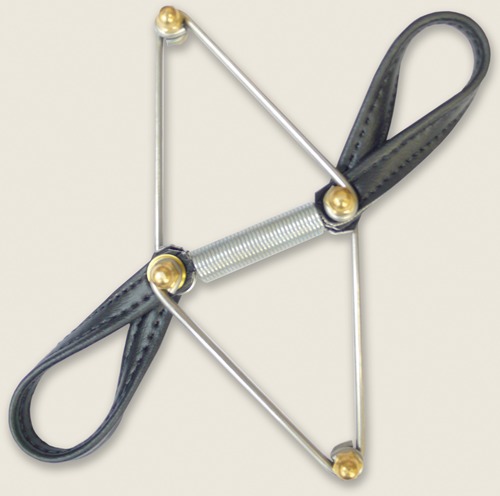
The toe corrector (image courtesy of Gratz Industries, Long Island City, New York).
Figure 16.
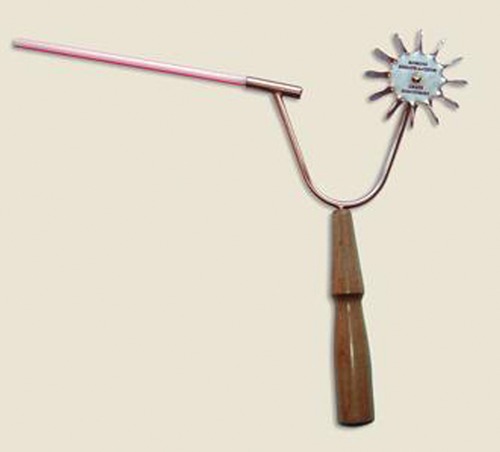
The breath-a-cizer (image courtesy of Gratz Industries, Long Island City, New York).
Outcome Studies
A training study of 20 participants randomized the use of a mirror for learning the star (an advanced Pilates exercise) over 7 weeks.49 Quantitative evaluation using video analysis before and after the training assessed lateral alignment of the body. Visual feedback from the mirror did not enhance subsequent performance.
A randomized trial of 30 girls (10 to 12 years old) included 14 in YMCA activities that were offered free Pilates classes.39 Sixteen girls (intervention group) participated in group mat Pilates classes 5 days per week, 1 hour per session, for a 4-week period. The body mass index (BMI) percentile of these young girls was lowered in this pilot study. There was a 3.1-percentile reduction in the BMI in the treatment group, while the control group increased by 0.8 percentiles. Greater changes occurred in participants with low initial values where a small change in BMI resulted in a larger drop in BMI percentile. The figure for the control group is more mixed, with lower initial values among some participants and a slightly smaller sample. Thus, the results indicate a disproportionate drop in the BMI percentile of healthy girls and suggest that the effect of the intervention was not uniform among participants.39
The effectiveness of Pilates versus taiji quan (tai chi chuan; a Chinese martial art practiced for defense training and health) on perceived self-efficacy, sleep quality, mood, strength, and balance was evaluated in college-age individuals using a comparative controlled study (group mat classes over the 15 weeks, 2 times per week × 75 minutes or 3 times per week × 50 minutes).10 Self-efficacy and mood improved significantly in the Pilates group. There were no differences between groups in sleep quality, strength, and balance. Group and sex representation were not balanced.
Twenty-six healthy participants with at least 6 months of classical Pilates training were recruited for a repeated-measures study to analyze Pilates exercises with or without the abdominal drawing-in maneuver.23 Ultrasound was used to detect activity in the TrA and internal oblique muscles. Pilates exercises activated the TrA and internal oblique, but they did not function independently. The reformer apparatus increased activation of the TrA. There were no significant differences in muscle activation between exercises during higher effort or more complex exercises.
Thirty-nine volunteers were recruited to assess 3 Pilates regimes as a home exercise program for chronic, mild low back pain.17 Load transfer through the pelvis was monitored using the 1-legged standing stork test.17 All 3 groups experienced statistically significant reductions in frequency, intensity, and duration of low back pain with no significant differences between the groups.
A single blinded randomized controlled trial with 11 healthy controls and 17 participants evaluated the effectiveness of Pilates on low back pain (8 performed Pilates exercises 2 times per week for 15 sessions and 9 did not).18 Gait analysis demonstrated improvement only in the Pilates training group. Pilates was comparable to Back School in 43 patients with nonspecific low back pain.20
A randomized trial of “usual care” and modified Pilates evaluated 39 physically active participants with chronic low back pain.62 Modified Pilates was more efficacious, decreased pain, and improved general health, flexibility, and proprioception.
Overall, only 3 of the 9 studies analyzed were classical Pilates.23,49,62 Some justification was offered for the derivative forms of the Pilates (ie, modified, Pilates based, or Pilates inspired) because the neuromuscular demands of the traditional Pilates method can be quite high62 and complex.28
Discussion
Pilates recognized that motor functions of the brain control the mobility and stability of the body, activating specific muscles in a functional sequence at controlled speeds and emphasizing quality, precision, and control of movement.27 Regular practice should lead to relaxation, control of the mind, enhanced body and self-awareness, improved core stability, coordination and posture, uniform muscle development, and decreased stress.46,60 Complex movements are broken down step-by-step to internalize the pattern.25,59,60,72
People of all ages and levels of conditioning may benefit from Pilates; however, confirming research is lacking. The effectiveness of Pilates is dependent on the instructor’s training.7,25,45 Instructor certification requirements are variable.25,47,61 Pilates is being integrated increasingly into rehabilitation programs by clinicians without appropriate training.7,8,25 Clinicians should consider these limitations when prescribing Pilates training for both patients and athletes. In addition, the high neuromuscular demands of the the original Pilates method, requiring total core strength, total arm strength, and total leg strength, make its adaptation for rehabilitation challenging. It remains to be seen if the classical approach or any of its derivative forms is more efficacious than traditional rehabilitation programs. To answer this question, well designed, longitudinal clinical trials with standardized patient-reported and clinical performance measures are necessary.
Acknowledgments
The author thanks Olivia Di Lorenzo, JW Matheson, and True Pilates New York for their assistance with manuscript preparation.
Footnotes
References
- 1. Allison GT, Morris SL, Lay B. Feedforward responses of transversus abdominis are directionally specific and act asymmetrically: implications for core stability theories. J Orthop Sports Phys Ther. 2008;38:228-237 [DOI] [PubMed] [Google Scholar]
- 2. Akuthota V, Nadler SF. Core strengthening. Arch Phys Med Rehabil. 2004;85(3):S86-S92 [DOI] [PubMed] [Google Scholar]
- 3. Arokoski JP, Valta T, Airaksinen O, et al. Back and abdominal muscle function during stabilization exercises. Arch Phys Med Rehabil. 2001;82:1089-1098 [DOI] [PubMed] [Google Scholar]
- 4. Barnett F, Gilleard W. The use of lumbar stabilization techniques during the performance of abdominal strengthening exercise variations. J Sports Med Phys Fitness. 2005;45:193-201 [PubMed] [Google Scholar]
- 5. Bergmark A. Stability of the lumbar spine: a study in mechanical engineering. Acta Orthop Scand. 1989;230:20-24 [DOI] [PubMed] [Google Scholar]
- 6. Behm DG, Leonard AM, Young WB, Bonsey WA, MacKinnon SN. Trunk muscle electromyographic activity with unstable and unilateral exercises. J Strength Cond Res. 2005;19:193-201 [DOI] [PubMed] [Google Scholar]
- 7. Bernardo LM. The effectiveness of Pilates training in healthy adults: an appraisal of the research literature. J Body Mov Ther. 2007;11:106-110 [Google Scholar]
- 8. Bernardo LM, Nagle EF. Does Pilates training benefit dancers? An appraisal of Pilates research literature. J Dance Med Sci. 2006;10:46-50 [Google Scholar]
- 9. Bullock-Saxton JE, Janda V, Bullock MI. The influence of ankle sprain injury on muscle activation during hip extension. Int J Sports Med. 1994;15(6):330-334 [DOI] [PubMed] [Google Scholar]
- 10. Caldwell K, Harrison M, Adams M, Triplett NT. Effect of Pilates and taiji quan training on self-efficacy, sleep, quality, mood, and physical performance of college students. J Body Mov Ther. 2009;13:155-163 [DOI] [PubMed] [Google Scholar]
- 11. Carmichael M. Stronger, faster, smarter. Newsweek. March 26, 2007 [PubMed] [Google Scholar]
- 12. Carter JM, Beam WC, McMahan SG, et al. The effect of stability ball training on spinal stability in sedentary individuals. J Strength Cond Res. 2006;20:429-435 [DOI] [PubMed] [Google Scholar]
- 13. Cech DJ, Martin S. Functional Development Across Life Span. 2nd ed. Philadelphia, PA: Saunders; 2002 [Google Scholar]
- 14. Chang Y. Grace under pressure. Newsweek. February 28, 2000 [PubMed] [Google Scholar]
- 15. Cholewicki J, Van Vliet JJT. Relative contribution of trunk muscles to the stability of the lumbar spine during isometric exertions. Clin Biomech (Bristol, Avon). 2002;17:99-105 [DOI] [PubMed] [Google Scholar]
- 16. Coles K, Tomporowski PD. Effects of acute exercise on executive processing, short-term and long-term memory. J Sports Sci. 2008;26:333-344 [DOI] [PubMed] [Google Scholar]
- 17. Curnow D, Cobbin D, Wyndham J, Boris Choy ST. Altered motor control, posture and the Pilates method of exercise prescription. J Bodyw Mov Ther. 2009;13:104-111 [DOI] [PubMed] [Google Scholar]
- 18. da Fonseca JL, Magini M, de Freitas TH. Laboratory gait analysis in patients with low back pain before and after a Pilates intervention. J Sport Rehabil. 2009;18:269-282 [DOI] [PubMed] [Google Scholar]
- 19. Davies GJ, Ellenbecker TS. Total Arm Strength for Shoulder and Elbow Overuse Injuries [home study course]. La Crosse, WI: Upper Extremity Orthopaedic Section; 1993 [Google Scholar]
- 20. Donzelli S, Di Domenica E, Cova AM, Galletti R, Giunta N. Two different techniques in the rehabilitation treatment of low back pain: a randomized controlled trail. Eura Medicophys. 2006;42:205-210 [PubMed] [Google Scholar]
- 21. Drysdale CL, Earl JE, Hertel J. Surface Electromyographic Activity of the Abdominal Muscles During Pelvic-Tilt and Abdominal-Hollowing Exercises. J Athl Train. 2004;39(1):32-36 [PMC free article] [PubMed] [Google Scholar]
- 22. Ellenbecker TS, Davies GJ. Closed kinetic chain exercise : a comprehensive guide to multiple joint exercise. Champaign, Ill.: Human Kinetics; 2001 [Google Scholar]
- 23. Endleman I, Critchley DJ. Transversus abdominis and obliquus internus activity during Pilates exercises: measurement with ultrasound scanning. Arch Phys Med Rehabil. 2008;89:2205-2212 [DOI] [PubMed] [Google Scholar]
- 24. Faries MD, Greenwood M. Core training: stabilizing the confusion. Strength Cond J. 2007;29:10-25 [Google Scholar]
- 25. Fiasca P. Discovering Pure Classical Pilates. 2nd ed. Peter Fiasca; 2009 [Google Scholar]
- 26. Friedman P, Eisen G. The Pilates Method of Physical and Mental Conditioning. New York, NY: Penguin Books; 2005 [Google Scholar]
- 27. Gallagher SP, Kryzanowska R. The Joseph H. Pilates Archive Collection. Philadelphia, PA: Bain Bridge Books; 2000 [Google Scholar]
- 28. Gladwell V, Head S, Haggar M, et al. Does a program of Pilates improve chronic non-specific low back pain? J Sport Rehabil. 2006;15:338-350 [Google Scholar]
- 29. Gleim GW, Nicholas JA, Webb JW. Isokinetic evaluation following leg injuries. Phys Sportsmed. 1978;6:74-82 [DOI] [PubMed] [Google Scholar]
- 30. Grenier SG, McGill SM. Quantification of lumbar stability by using 2 different abdominal activation strategies. Arch Phys Med Rehabil. 2007;88(1):54-62 [DOI] [PubMed] [Google Scholar]
- 31. Hagins M, Adler K, Cash M, et al. Effects of practice on the ability to perform lumbar stabilization exercises. J Orthop Sports Phys Ther. 1999;29:546-555 [DOI] [PubMed] [Google Scholar]
- 32. Herrington L, Davies R. The influence of Pilates training on the ability to contract the transversus abdominis muscle in asymptomatic individuals. J Body Mov Ther. 2005;9:52-57 [Google Scholar]
- 33. Hides J, Wilson S, Stanton W, et al. An MRI investigation into the function of the transversus abdominis muscle during “drawing in” of the abdominal wall. Spine. 2006;31:175-178 [DOI] [PubMed] [Google Scholar]
- 34. Hodges PW. Is there a role for transversus abdominis in lumbo-pelvic stability? Man Ther. 1999;4:74-86 [DOI] [PubMed] [Google Scholar]
- 35. Hodges PW, Cresswell AG, Daggfeldt K, Thorsensson A. In vivo measurement of the effect of intra-abdominal pressure on the human spine. J Biomech. 2001;34:347-353 [DOI] [PubMed] [Google Scholar]
- 36. Hodges PW, Richardson CA. Inefficient muscular stabilization of the lumbar spine associated with low back pain: a motor control evaluation of transversus abdominis. Spine. 1996;21:2640-2650 [DOI] [PubMed] [Google Scholar]
- 37. Hodges PW, Richardson CA. Transversus abdominis and the superficial abdominal muscles are controlled independently in a postural task. Neurosci Lett. 1999;265:91-94 [DOI] [PubMed] [Google Scholar]
- 38. IDEA Fitness Journal 2008;5(4). http://www.ideafit.com [Google Scholar]
- 39. Jago R, Jonker ML, Missaghian M, Baranowski T. Effect of 4 weeks of Pilates on the body composition of young girls. Prev Med. 2006;42:177-180 [DOI] [PubMed] [Google Scholar]
- 40. Janda V. Muscle function testing. London; Boston: Butterworths; 1983 [Google Scholar]
- 41. Jull GA, Richardson CA. Motor control problems in patients with spinal pain: a new direction for therapeutic exercise. J Manipulative Physiol Ther. 2000;23:115-117 [PubMed] [Google Scholar]
- 42. Kendall HO. Posture and pain. Baltimore: Williams and Wilkins; 1952 [Google Scholar]
- 43. Kibler WB, Press J, Sciascia A. The role of core stability in athletic function. Sports Med. 2006;36:189-198 [DOI] [PubMed] [Google Scholar]
- 44. Knott M, Voss DE. Proprioceptive Neuromuscular Rehabilitation. 2nd ed. New York: Harper & Row; 1968 [Google Scholar]
- 45. Lange C, Unnithan V, Larkam E, Latta PM. Maximizing the benefits of Pilates-inspired exercise for learning functional motor skills. J Bodyw Mov Ther. 2000;4:99-108 [Google Scholar]
- 46. Latey P. The Pilates method: history and philosophy. J Bodyw Mov Ther. 2001;5:275-282 [Google Scholar]
- 47. Liekens B. The Pilates Studio Teacher Training Manual: Part I—Basic/Intermediate. New York, NY: The Pilates Studio; 1997 [Google Scholar]
- 48. Logan GA, McKinney WC. Kinesiology. Los Angeles, CA: Wm C Brown Company Publishers; 1970 [Google Scholar]
- 49. Lynch JA, Chalmers GR, Knutzen KM, Martin LT. Effect on performance of learning a Pilates skill with or without a mirror. J Bodyw Mov Ther. 2009;13:283-290 [DOI] [PubMed] [Google Scholar]
- 50. McDermott MJ. Wellness trend creates opportunities in health, nutrition, and fitness sectors. Business Opportunities. http://www.busop1.com/wellness.html Accessed July 19, 2009
- 51. McGill SM. Electromyographic activity of the abdominal and low back musculature during the generation of isometric and dynamic axial trunk torque: implications for lumbar mechanics. Journal of orthopaedic research: official publication of the Orthopaedic Research Society. 1991;9(1):91-103 [DOI] [PubMed] [Google Scholar]
- 52. McGill SM. Low back stability: from formal description to issues for performance and rehabilitation. Exerc Sport Sci Rev. 2001;29:26-31 [DOI] [PubMed] [Google Scholar]
- 53. McGill SM, Grenier S, Kavcic N, Cholewicki J. Coordination of muscle activity to assure stability of the lumbar spine. J Electromyogr Kinesiol. 2003;13:353-359 [DOI] [PubMed] [Google Scholar]
- 54. Muscolino JE, Cipriani S. Pilates and the “powerhouse”: I. J Bodyw Mov Ther. 2004;8:15-24 [Google Scholar]
- 55. Muscolino JE, Cipriani S. Pilates and the “powerhouse”: II. J Bodyw Mov Ther. 2004;8:122-130 [Google Scholar]
- 56. Nicholas JA, Strizak AM, Vegas G. A study of thigh muscle weakness in different pathological states of the lower extremity. Am J Sports Med. 1976;4:241-248 [DOI] [PubMed] [Google Scholar]
- 57. O’Sullivan PB, Twomey LT, Allison GT. Evaluation of specific stabilizing exercise in the treatment of chronic low back pain with radiologic diagnosis of spondylolysis or spondylolisthesis. Spine (Phila Pa 1976). 1997;22(24):2959-2967 [DOI] [PubMed] [Google Scholar]
- 58. Panjabi M, Yamamoto I, Oxland T, Crisco J. How does posture affect coupling in the lumbar spine? Spine (Phila Pa 1976). 1989;14(9):1002-1011 [DOI] [PubMed] [Google Scholar]
- 59. Pilates JH. Your Health. Incline Village, NV: Presentation Dynamics Inc; 1998 [Google Scholar]
- 60. Pilates JH, Miller WJ. Pilates’ Return to Life Through Contrology. New York, NY: JJ Augustin; 1945 [Google Scholar]
- 61. Richardson CA, Snijders CJ, Hides JA, Damen L, Pas MS, Storm J. The relation between the transversus abdominis muscles, sacroiliac joint mechanics, and low back pain. Spine. 2002;27:399-405 [DOI] [PubMed] [Google Scholar]
- 62. Rydeard R, Leger A, Smith D. Pilates-based therapeutic exercise: effect on subjects with nonspecific chronic low back pain and functional disability. A randomized controlled trail. J Orthop Sports Phys Ther. 2006;36:472-484 [DOI] [PubMed] [Google Scholar]
- 63. Schexneider MA, Catlin PA, Davies GJ, Mattson PA. An isokinetic estimation of total arm strength. Isok Ex Sci. 1991;1:117-121 [Google Scholar]
- 64. Schmidt RA. Motor Learning and Performance: From Principles to Practice. Champaign, IL: Human Kinetics Books; 1991 [Google Scholar]
- 65. Shumway-Cook A, Woollacott M. Motor Control: Theory and Practical Applications. 3rd ed. Baltimore, MD: Williams & Wilkins; 2007 [Google Scholar]
- 66. Stanton T, Kawchuk G. The effect of abdominal stabilization contractions on posteroanterior spinal stiffness. Spine (Phila Pa 1976). 2008;33(6):694-701 [DOI] [PubMed] [Google Scholar]
- 67. Strizak AM, Gleim GW, Sapega A, Nicholas JA. Hand and forearm strength and its relation to tennis. Am J Sports Med. 1983;11(4):234-239 [DOI] [PubMed] [Google Scholar]
- 68. Strohl KP, Mead J, Banzett RB, Loring SH, Kosch PC. Regional differences in abdominal muscle activity during various maneuvers in humans. J Appl Physiol. 1981;51(6):1471-1476 [DOI] [PubMed] [Google Scholar]
- 69. Thompson WR. Worldwide survey reveals fitness trends for 2009. ACSM Health Fitness J. 2009;12:1-8 [Google Scholar]
- 70. Tomporowski PD. Effects of acute bouts of exercise on cognition. Acta Psychol (Amst). 2003;112:297-324 [DOI] [PubMed] [Google Scholar]
- 71.USA Today. [Published October 29, 2007]. Exercise builds strong brains, too. http://www.usatoday.com/news/health/2007-10-29-exercise-brains_N.htm.
- 72. Vera-Garca FJ, Grenier SG, McGill SM. Abdominal muscle response during curl-ups on both stable and labile surfaces. Phys Ther. 2000;80:564-569 [PubMed] [Google Scholar]
- 73. Wainner RS, Whitman JM, Cleland JA, Flynn TW. Regional interdependence: a musculoskeletal examination model whose time has come. J Orthop Sports Phys Ther. 2007;37(11):658-660 [DOI] [PubMed] [Google Scholar]
- 74. Weinberg J. Level 2: Romana’s Pilates Senior Teacher Trainer, True Pilates New York [pilates teacher training certification]. New York, NY: True Pilates; 2008 [Google Scholar]
- 75. Winstein CJ. Designing practice for motor learning; clinical implications. In: Contemporary Management of Motor Control Problems: Proceedings of the II Step Conference Alexandria, VA: American Physical Therapy Association; 1991 [Google Scholar]
- 76. Wilke HJ, Wolf S, Claes LE, Arand M, Wiesend A. Stability increase of the lumbar spine with different muscle groups: a biomechanical in vitro study. Spine. 1995;20:192-198 [DOI] [PubMed] [Google Scholar]
- 77. Willardson JM. A periodized approach to core training. ACSM Health Fitness J. 2008;12:7-13 [Google Scholar]
- 78. Zazulak BT, Hewett TE, Reeves NP, et al. Deficits in neuromuscular control of the trunk predicts knee injury risk: a prospective biomechanical-epidemiologic study. Am J Sports Med. 2007;35:1123-1130 [DOI] [PubMed] [Google Scholar]


